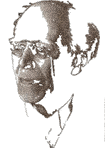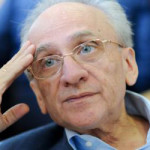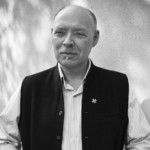The Stanislavski Centre is very pleased to announce the publication of three major works by our Advisory Board member, and co-editor of our journal, Stanislavski Studies, Professor Sergei Tcherkasski.
Theatre director Sergei Tcherkasski, is Head of an Acting Studio in the renowned Saint Petersburg Theatre Arts Academy (established in 1779). He is Professor of Acting and Directing and holds a Ph.D. for his research into the education of directors in Russia. His second dissertation (D.Sc.) resulted in his book Acting: Stanislavsky – Boleslavsky – Strasberg.
 His other Russian-language books include Stanislavsky and Yoga (2013, Japanese edition in 2015, English edition in 2016), Valentine Smyshliaev – Actor, Director and Teacher (2004), Sulimov’s School of Directing (2013). They form a kind of trilogy representing Tcherkasski’s professional family tree which grows directly from Stanislavsky to Valentin Smyshliaev (member of the First Studio of Moscow Art Theatre who also directed Michael Chekhov in Hamlet) and then to Mar Sulimov (one of the leading Russian teachers of directing of the 20th century).
His other Russian-language books include Stanislavsky and Yoga (2013, Japanese edition in 2015, English edition in 2016), Valentine Smyshliaev – Actor, Director and Teacher (2004), Sulimov’s School of Directing (2013). They form a kind of trilogy representing Tcherkasski’s professional family tree which grows directly from Stanislavsky to Valentin Smyshliaev (member of the First Studio of Moscow Art Theatre who also directed Michael Chekhov in Hamlet) and then to Mar Sulimov (one of the leading Russian teachers of directing of the 20th century).
Tcherkasski has directed more than three dozen classical and modern plays. Two of his productions – Dangerous Liaisons and Great Catherine – ran in Saint Petersburg for twelve and sixteen years respectively. His international directing credits include Great Catherine by Shaw and Duck Hunting by Vampilov at RADA (London), The Inspector General by Gogol at the National Theatre of Romania (Bucharest) and Flight by Bulgakov at NIDA (Sydney).
Stanislavsky and Yoga. (Routledge / Icarus, 2016) https://www.routledge.com/Stanislavsky-and-Yoga/Tcherkasski/p/book/9781138954083 Is a further development of articles published in the Centre’s journal, Stanislavski Studies.
This book deals with one of the most important sources of the Stanislavski System - Yoga, its practice and philosophy. Sergei Tcherkasski carefully collects records on Yoga in Stanislavski’s writings from different periods and discusses hidden references which are not explained by Stanislavsky himself due to the censorship in his day. Vivid examples of Yoga based training from the rehearsal practice of the Moscow Art Theatre and many of Stanislavski’s studios are provided.
The focus of Tcherkasski’s research consists of a comparative reading of the Stanislavski System and Yogi Ramacharaka’s books, which were a main source for Stanislavski. Accordingly, Tcherkasski analyzes elements of the System based on Yoga principles. Among them are:
- relaxation of muscles (muscular release),
- communication and prana,
- emission of rays and reception of rays,
- beaming of aura,
- sending of prana,
- attention,
- visualizations (mental images).
Special attention is paid to the idea of the superconscious in Yoga, and in Ramacharaka’s and Stanislavski’s theories.
Tcherkasski’s wide-ranging analysis has resulted in new and intriguing discoveries about the Russian master. Furthermore, he reveals the extent to which Stanislavsky anticipated modern discoveries in neurobiology and cognitive science.
In this book Tcherkasski acts as a researcher, historian, theatre director, and experienced acting teacher. He argues that some forty per cent of basic exercises in any Stanislavsky based actor training program of today are rooted in Yoga. Actors, teachers, and students will find it interesting to discover that they are following in the footsteps of Yoga in their everyday Stanislavsky based training and rehearsals.
Acting: Stanislavsky – Boleslavsky – Strasberg: History, Theory and Practice.
(St. Petersburg: SPbGATI, 2016. In Russian).
This book contains fundamental research on the directing and teaching of Richard Boleslavsky (1889–1937) and Lee Strasberg (1901–1982) as a development of the Stanislavski System.
The author closely scrutinizes documents of the life and work of the Moscow Art Theatre and its First Studio that became a  cradle for the most important discoveries of Stanislavsky into actor training in the 1900s and 1910s. The book continues with exploration of the artistic creation and training methodology of the American Laboratory Theatre (1923–1930), the Group Theatre (1931–1940) and the Actors Studio (since 1947). The work of these three forms the most important line of continuity in the history of American theatre in the 20th century. The methodological legacy of Boleslavsky and Strasberg is examined with an emphasis on the analysis of their major books Acting: The First Six Lessons and Dream of Passion. A comparative reading of these books with those of Stanislavsky is not only refreshing but also practically useful.
cradle for the most important discoveries of Stanislavsky into actor training in the 1900s and 1910s. The book continues with exploration of the artistic creation and training methodology of the American Laboratory Theatre (1923–1930), the Group Theatre (1931–1940) and the Actors Studio (since 1947). The work of these three forms the most important line of continuity in the history of American theatre in the 20th century. The methodological legacy of Boleslavsky and Strasberg is examined with an emphasis on the analysis of their major books Acting: The First Six Lessons and Dream of Passion. A comparative reading of these books with those of Stanislavsky is not only refreshing but also practically useful.
The study is conducted on several levels – different chapters open new pages in the history of American and Russian theatre of the 20th century, raise fundamental questions on the art of acting and actor training and provide specific exercises from the practice of Stanislavsky, Boleslavsky and Strasberg.
Tcherkasski’s work is based on archival documents and considers many Russian and American publications. It contains 390 photographs from nearly 20 museums and private collections in Moscow, St. Petersburg, Warsaw, New York, Paris, etc. Some of them are published for the first time in the literature of world theatre.
The publication is addressed to all people of the theatre – experienced actors and acting students, theatre critics and historians, theatre directors and teachers of acting, theatergoers and all those who are interested in Russian–American cultural links.
“I am thrilled that those with an interest in acting and the theater arts in Stanislavsky’s homeland now will be able to gain a deeper understanding of Lee Strasberg’s work.” (Anna Strasberg, Artistic Director & Co-Founder, Lee Strasberg Theatre and Film Institute ®)
“I learned so much that was new and unexpected. I know of no other Russian researcher who has a similar degree of competence, passion and enthusiasm for research to sift through the mountains of material without getting get stuck in them and to come to such clear and, I would say, inspiring conclusions.” (Valery Galendeev, Head of Department of Voice and Speech, Russian State Institute of Performing Arts (St. Petersburg State Theatre Arts Academy).
“Sergei Tcherkasski’s book ably puts many things right.” (Lev Dodin, Artistic Director, Maly Drama Theatre – Theater of Europe).
The Good Hope” on Mokhovaya Street — 100 years later: Reconstruction of Actor Training at the First Studio of the Moscow Art Theatre. Ed. S.Tcherkasski.
(St. Petersburg: Baltic Seasons Publishing, 2016) in Russian.
The Good Hope by Heijermans was the first production of the First Studio of the Moscow Art Theatre which started its legendary history. It was staged in 1913 and the same year was performed during the tour of the Studio to St. Petersburg. Ironically, the show ran at the Tenishev Hall on Mokhovaya Street that now belongs to the St. Petersburg State Theatre Arts Academy — Russian State Institute of Performing Arts. This book is devoted to the Re: FirstStudio Project that took place there in 2012–2016.
For three years, students and teachers of Tcherkasski’s Studio followed the initial steps of the First Studio founded in 1912. The aim was to get a better understanding of the methodology of actor training under Stanislavski and Sulerzhitsky’s guidance in the early (to be more precise — basic) period of the Stanislavski System.
The multidisciplinary project resulted in both theoretical discoveries about and intimate insights into the artistic work of the founding members of the First Studio. Students not only were engaged in their modern Stanislavski-based training, but they also delved into archives and made etudes based on memoirs of the First Studio actors who subsequently became the great and influential masters of the Russian and international stage — Evgeny Vakhtangov, Michael Chekhov, Richard Boleslavsky, Maria Ouspenskaya, Sofia Giatsintova, Boris Sushkevich, Serafima Birman, Leo Bulgakov, among them.
The climax of the Re: FirstStudio Project became today’s productions of the once famous The Good Hope by Heijermans, The Cricket on the Hearth by Dickens and A Month in the Country by Turgenev. They were in the repertoire of the Academy’s Theatre in 2015–2016 and were performed over seventy times. In addition, young directors of the TV Department filmed a version of The Good Hope production.
This book consists of research materials and archival photos of the 1913 production of The Good Hope (I. Mikhailova, I. Tsimbal, S. Tcherkasski), articles by faculty members who led the Re: FirstStudio Project (S. Tcherkasski, P. Stepanova) and the 2015 production reviews by notable Russian critics (I. Soloviova, N. Pesochinsky, I. Boikova) as well as by international scholars who saw the production during the IV St. Petersburg International Cultural Forum in 2015 — D. Trubotchkin and V. Shcherbakov (Russia), D. Willis (UK), D. Drozd (Czech Republic), H. Brouwer (Netherlands), B. Picon-Vallen (France).



